Today brings the release of one of the most anticipated films of the year – The Hobbit: The Desolation of Smaug. Most people who have followed the series will find plenty to enjoy with this effort. It features far more action and drama and much less plot exposition than the previous installment. Some of the big action set pieces are truly spectacular, with the barrel sequence being a particularly memorable highlight. Personally, I had a good time.
To help get you in the mood, here’s some trivia about all of director Peter Jackson’s Hobbit and Lord of the Rings films that have been released so far. The information about this remarkable series comes from various sources, including press notes, news stories and making-of documentaries. Enjoy!
The Lord of the Rings: The Fellowship of the Ring (2001)
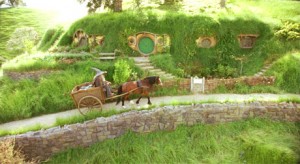 -Peter Jackson and his wife Fran Walsh originally hoped to adapt the properties of The Hobbit and The Lord of the Rings into a trilogy of films. Working with Miramax, they learned that the rights to The Hobbit were unavailable (the property was owned by United Artists, an MGM company). As a result, they were told by Miramax to ignore The Hobbit and begin work developing The Lord of the Rings as two films.
-Peter Jackson and his wife Fran Walsh originally hoped to adapt the properties of The Hobbit and The Lord of the Rings into a trilogy of films. Working with Miramax, they learned that the rights to The Hobbit were unavailable (the property was owned by United Artists, an MGM company). As a result, they were told by Miramax to ignore The Hobbit and begin work developing The Lord of the Rings as two films.
-Upon seeing the scale of the first script written, Miramax suggested that all three books be condensed into a single film. With the insistence of Peter Jackson and Fran Walsh that the three books could not be adapted into one movie and that two movies would be required, the studio allowed them to shop the property to other companies.
-After a successful meeting, The Lord of the Rings ultimately found a home at New Line Cinema. President Robert Shaye requested, however, that instead of two films, Jackson and Walsh adapt the books into a trilogy. Phillipa Boyens was hired to co-write new, completely restructured scripts with Jackson and Walsh.
-Preproduction was extensive and took more than a year to complete. Jackson first created a feature length video animatic of the film using storyboards and voice actors. Later, sequences were recreated using digital pre-visualization techniques developed at Lucasfilm as well as miniature models of sets to help determine camera angles.
-The Hobbiton exteriors were built and allowed to sit for a year before shooting began to allow the natural organic plants to grow to an appropriate height and length.
-Make-Up house Weta Workshop produced an incredible amount of prosthetics used in Fellowship and the following two features. This included over 10,000 facial appliances and 1800 body suits for the various species and creatures featured. Due to the rigorous demands of shooting, 1800 pairs of large prosthetic foam latex hobbit feet were worn in the films by the 4 leads.
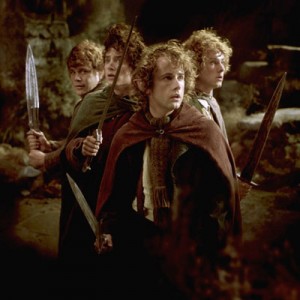 -Most of the performers were cast without having met one another. There was some concern about how they would bond. The actors portraying hobbits arrived roughly six weeks before shooting, with the first two months of filming consisting mostly of scenes between their characters.
-Most of the performers were cast without having met one another. There was some concern about how they would bond. The actors portraying hobbits arrived roughly six weeks before shooting, with the first two months of filming consisting mostly of scenes between their characters.
-A different actor played Aragorn at the beginning of production. Reportedly, it was determined after shooting began that Stuart Townsend (The League of Extraordinary Gentlemen), looked too young to continue in the role. Viggo Mortensen was contacted, but wasn’t familiar with the property and leery about the short notice and time commitment involved. However, his son was a fan of the books and convinced him to take the part.
-The reported cost of this installment was $93 million dollars. It ultimately grossed more than $871 million worldwide. It was nominated for 13 Academy awards, including Best Picture, and won four, including nods for Cinematography, Make-Up, Score and Visual Effects.
The Lord of the Ring: The Two Towers (2002)
-Many involved considered this the most difficult book to adapt, due to the unusual plotting of the source material (which involved separate story lines), the elaborate scale of the Helm’s Deep battle and the difficulty involved in creating the Gollum character.
-Despite it coming at the end of the second novel, the Shelob spider was always intended to be pushed back into the third film. The filmmakers didn’t want to undercut the impact of the Helm’s Deep climax by inter-cutting or following it with the Shelob confrontation. In editing, the fate of Sauron was also considered anti-climactic compared to the battle and it was pushed into the third movie.
-Initially, New Line wasn’t convinced that a computer-generated Gollum would engage viewers and give an articulate enough performance. New Line President Bob Shaye eventually agreed after seeing test footage.
-Andy Serkis was cast as the voice of Gollum. He used the sound of his own cat coughing up fur balls as the basis for the character’s voice.
-Serkis’s audition performance was so strong that Jackson decided to based the entire character around both the actor’s physical and vocal performance. He was hired to act on set with the cast as reference for the digital work that would follow. In may instances, animators would digitally remove the actor from the plates with other actors and insert the CG Gollum character in his place.
-Despite Gollum already appearing briefly in the first film, the character was redesigned and altered in this film in order to look more like Serkis. Fran Walsh added a “schizophrenic” scene of Gollum talking to himself in order to add more depth to the character.
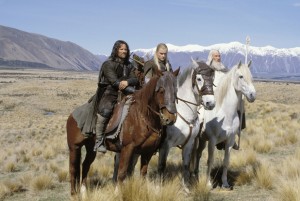 -After discovering a mass of bodies on a plain that he thinks may include hobbits Merry and Pippin, the character of Aragorn kicks a helmet and lets out a guttural wail. The scream was actually the result of two toes that had just broken from booting the helmet.
-After discovering a mass of bodies on a plain that he thinks may include hobbits Merry and Pippin, the character of Aragorn kicks a helmet and lets out a guttural wail. The scream was actually the result of two toes that had just broken from booting the helmet.
-It took more than three months of night shooting under rain machines in a deep quarry to complete the Helm’s Deep sequence.
-The movie cost an estimated $94 million dollars and its final tally in worldwide grosses was $926 million. It was nominated for six Oscars including Best Picture, and won for Sound Editing and Visual Effects.
The Lord of the Rings: The Return of the King (2003)
-A Tunnel-web spider was used as the design inspiration of Shelob. The natural spider’s face wasn’t scary enough, so numerous version were created. The children of Peter Jackson and Fran Walsh picked what they thought was the scariest design, and it was what was ultimately used.
-After being forced indoors due to poor weather during the shooting of The Fellowship of the Ring, Jackson chose to begin shooting the emotional scene from The Return of the King in which Frodo casts out Sam. Sam’s coverage was completed, but the reverse shots in the same scene with Frodo and Gollum were not filmed until more than a year afterward.
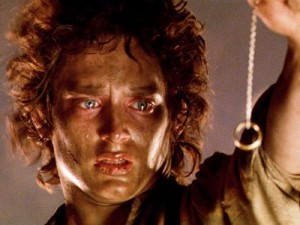 -The climax featuring the struggle between Frodo and Gollum in Mount Doom was altered from the source material to allow the Frodo character a more pro-active role in the finale. However, as originally shot, Frodo came across in a negative light. With only a day before the performers wrapped principal photography and left the country, the filmmakers quickly reworked, re-staged and re-shot the confrontation as it now appears in the finished product.
-The climax featuring the struggle between Frodo and Gollum in Mount Doom was altered from the source material to allow the Frodo character a more pro-active role in the finale. However, as originally shot, Frodo came across in a negative light. With only a day before the performers wrapped principal photography and left the country, the filmmakers quickly reworked, re-staged and re-shot the confrontation as it now appears in the finished product.
-In order to coax an appropriately large smile out of actor Sean Astin (Sam) on camera in the last shot of the wedding scene near the end of the movie, actors Viggo Mortensen (Aragorn) and Billy Boyd (Pippin) stood off camera in the actor’s line of sight. Mortensen planted a big kiss on Boyd in the hopes of getting a genuine reaction from the Astin on film.
-Editing the film became much more difficult than initially anticipated. There were more storylines in the third film than in the second, and numerous sequences that had been bumped from of the second movie with the intent of being incorporated into the third added to the already sizable footage count.
-The film was budgeted at $94 million dollars and ultimately grossed nearly $1.2 billion around the world. It won eleven Oscars, including Best Picture. In fact, the film took home an Academy Award in every category for which it was nominated. The film is also only the second sequel to win Best Picture (the other was The Godfather Part II).
The Hobbit: An Unexpected Journey (2012)
-Following the success of the Lord of the Rings trilogy, numerous lawsuits were brought against New Line Cinema for withholding revenue earned from the films. Plaintiffs included the estate of the Tolkien family and director Peter Jackson. Settlements were eventually reached.
-After the overwhelming success of the original trilogy, MGM, who owned the rights to The Hobbit, expressed interest in co-producing the property with New Line (now a subsidiary of Warner Bros.). Peter Jackson was initially unwilling to direct, feeling that there was no way a new series of films could compete with the first ones.
-Instead, Guillermo del Toro was hired to helm the films. He began co-writing the film with Peter Jackson, Fran Walsh and Philippa Boyens. However, production was indefinitely delayed after the financial collapse of MGM (the studio was also forced to halt production on the third Daniel Craig James Bond film that would eventually become Skyfall). With the film still in limbo, del Toro eventually eft to pursue other projects. He is still credited as Project Consultant and Co-Writer with Jackson, Walsh and Boyens.
-Co-writer Boyens stated that del Toro’s version would have featured a different characterization of Bilbo. Other reports suggest there also would have been alternate casting choices (including Ron Perlman as Beorn), and the film would have used animatronics more extensively (as opposed to digital effects).
-After several years in development, millions spent in preproduction and MGM restructured, the film was finally green-lit. Despite other names being put forth as potential replacements for del Toro, the studios were insistent that Jackson return as director.
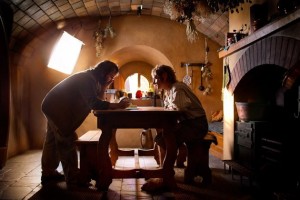 -Jackson was insistent that Martin Freeman play Bilbo Baggins, but initially the actor couldn’t accept the role due to his commitment with the BBC television series Sherlock. Jackson rescheduled the shooting schedule to coincide with a filming hiatus on the show. Freeman was then able to take on the part. His Sherlock co-star, Benedict Cumberbatch, also auditioned for and was cast as the voice of the dragon, Smaug.
-Jackson was insistent that Martin Freeman play Bilbo Baggins, but initially the actor couldn’t accept the role due to his commitment with the BBC television series Sherlock. Jackson rescheduled the shooting schedule to coincide with a filming hiatus on the show. Freeman was then able to take on the part. His Sherlock co-star, Benedict Cumberbatch, also auditioned for and was cast as the voice of the dragon, Smaug.
-Production stalled again just before shooting due to a dispute with the Screen Actors Guild. Numerous rumors and opinions have been expressed as to who was at fault. Regardless, it resulted in an impasse. Reports surfaced that the production would have to be moved to Eastern Europe. The Prime Minister of New Zealand eventually stepped in to resolve the conflict.
-Director Peter Jackson suffered a perforated ulcer and was briefly hospitalized just before shooting began.
-This was the first film to be shot and exhibited using High Frame Rate, specifically 48 frames per second (as opposed to 24 fps), using Red Epic digital cameras. The footage runs at 98 fps for 3D viewings (48 fps for each eye).
-Ultimately, the budget for all three films has been estimated at around $560 million (roughly $183 million per film). The final worldwide box office figure for the first chapter in the series was $1.02 billion.
-The film received three Academy Award nominations, including nods for Make-Up and Hairstyling, Visual Effects, and Production Design.
The Hobbit: The Desolation of Smaug (2013)
-The Orc villains Azog and Bolg were created using the same motion capture technique used to render Gollum. This method allowed the filmmakers to exaggerate their physical features (including battle armor that is embedded into flesh) and make them appear more intimidating. Their army comprised of a combination of actors in prosthetic make-up with additional digital warriors added in post-production.
-For the impressive toxic forest sequence, a set was built comprised of 32 giant trees carved out of polystyrene. The trees were more than 30 feet tall and could be rearranged to create new wooded environments as needed. Spiders were created digitally, but most of the webbing was a practical effect.
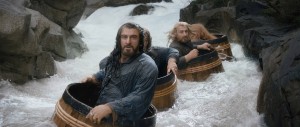 -Numerous methods were used to film the barrel sequence. This included an indoor river build in studio with 500 hp water jets. Some shots were filmed on location by a dam that would release water every feet hours and create a raging current. Cameras shot barrels from afar, and POV camera were also placed in the barrels, with digital doubles for the actor placed in afterwards.
-Numerous methods were used to film the barrel sequence. This included an indoor river build in studio with 500 hp water jets. Some shots were filmed on location by a dam that would release water every feet hours and create a raging current. Cameras shot barrels from afar, and POV camera were also placed in the barrels, with digital doubles for the actor placed in afterwards.
-The Lake-town environment was a new environment created for the filmic universe. Sets were inspired by wooden Celtic and Russian structures, while costuming embodied Eastern European, Siberian and Tibetan influences.
-The young actors playing the son and daughter of the Lake-town character Bard are actually the children of cast member James Nesbitt, who plays the dwarf Bofur.
-The Weta Digital team spent two and a half years designing and building the CG Smaug character from the skeleton out. Benedict Cumberbatch performed the role in motion capture gear on a sound stage to give the digital artists a physical reference for the dragon’s facial and body movements.
-The set for Smaug’s layer featured mats of stamped metal and rubber coins, covered in over 170,000 gold colored aluminum coins, 2000 goblets, as well and hundreds of other crystals and necklaces.


